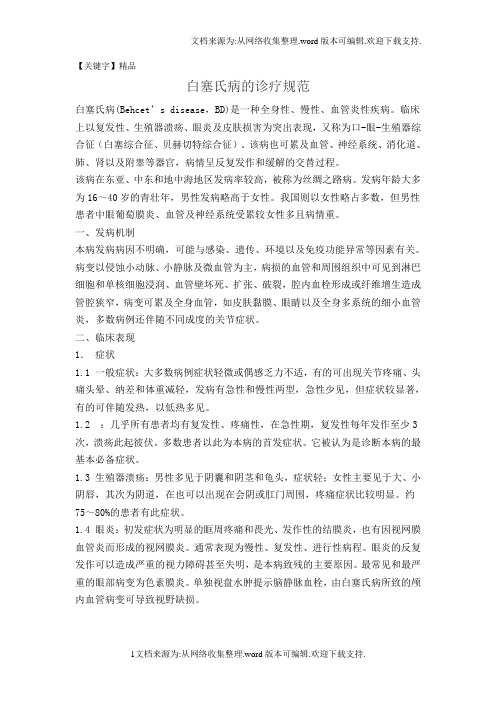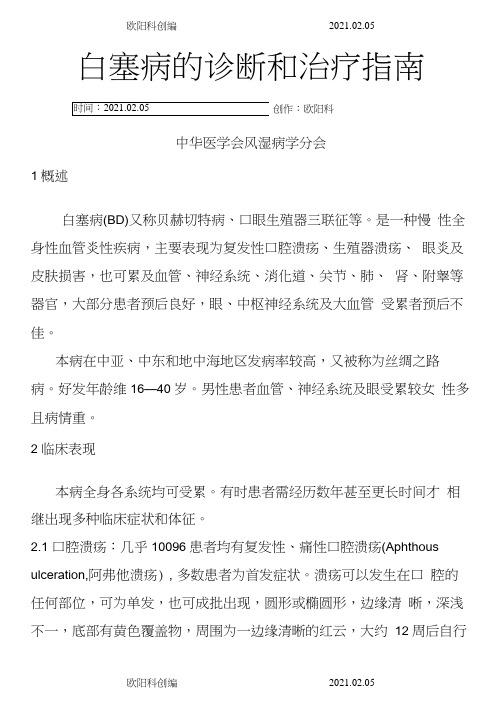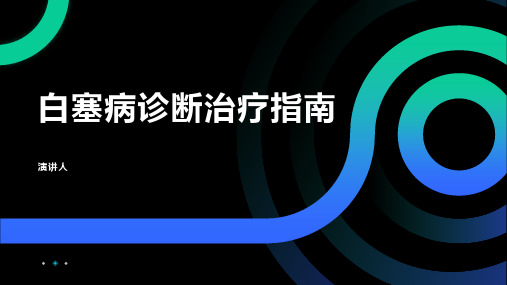EULAR 关于白塞病的指南
中医内科白塞病中医诊疗规范诊疗指南2023版

白塞病白塞病是以反复发作的口腔、生殖器溃疡和眼炎为主,多系统受累的炎性疾病,又称眼、口、生殖器三联综合征。
根据本病的临床表现,当与中医学”狐惑病”相似。
本病外因主要是感受淫邪毒气,内因主要是脏腑功能失调,尤以肝、脾、肾三脏功能失调为主。
病机主要是湿热毒邪蕴滞,湿热毒邪内蕴营分,外客于肌肤,或循经上蒸、下注,则发为本病。
【诊断】1口腔黏膜的再发性阿弗他性溃疡。
2 .皮肤症状可有结节性红斑、皮下血栓性静脉炎、皮肤针刺过敏反应或毛囊炎样瘗疮样皮疹。
3 .眼部症状有虹膜睫状体炎或视网膜脉络膜炎。
4.外阴部溃疡。
【治疗】一、辨证论治本病辨证主要是辨病之虚实,一般病程较短,局部肿痛明显,溃疡数目较多者,多为实;而病程较长,反复发作,肿痛不甚,溃疡数目不甚多,但难以愈合者,多属虚。
治疗当以清热除湿,泻火解毒为原则。
气郁化火者,佐以理气解郁;阴虚火旺者,滋阴降火;阴虚及阳,虚阳上扰者,又当温阳散火;病久不愈者,还应参入活血行瘀之品。
1 .肝脾湿热起病急,病程短,口腔黏膜及外阴溃疡,灼热疼痛,或下肢皮肤红斑结节,或伴有畏寒发热,心烦口干,胸闷纳呆,妇女带下黄稠,小漫短赤,舌苔黄腻,脉濡数或弦数。
治法:清热解毒,化湿和中。
方药举例:甘草泻心汤加减。
黄苓IOg,黄连5g,干姜3g,制半夏、党参各10g,生甘草5g,大枣5枚。
加减:若胸闷、纳呆,舌苔厚腻,加蕾香、佩兰各10g。
食少、便澹,加白术、茯苓各10g,赤小豆12go2 .气郁化火反复发生口腔及外阴溃疡,皮肤出现结节红斑,胸胁胀满,眼红目赤,心烦口苦,小便黄赤,大便干结,舌质红,苔黄腻,脉弦数。
治法:清肝泻火,疏利气机。
方药举例:龙胆泻肝丸加减。
龙胆草5g,桅子、黄苓各IOg,川木通6g,车前子(包煎)10g,柴胡6g,当归10g,生地黄12g,生甘草5g。
加减:若胸胁胀闷明显,妇女乳房作胀,月经不调,加香附、枳壳各IOg0气滞血瘀,皮疹紫暗,舌暗脉涩,加桃仁、红花各10g。
【精品】白塞氏病的诊疗规范

【关键字】精品白塞氏病的诊疗规范白塞氏病(Behcet’s disease,BD)是一种全身性、慢性、血管炎性疾病。
临床上以复发性、生殖器溃疡、眼炎及皮肤损害为突出表现,又称为口-眼-生殖器综合征(白塞综合征、贝赫切特综合征)。
该病也可累及血管、神经系统、消化道、肺、肾以及附睾等器官,病情呈反复发作和缓解的交替过程。
该病在东亚、中东和地中海地区发病率较高,被称为丝绸之路病。
发病年龄大多为16~40岁的青壮年,男性发病略高于女性。
我国则以女性略占多数,但男性患者中眼葡萄膜炎、血管及神经系统受累较女性多且病情重。
一、发病机制本病发病病因不明确,可能与感染、遗传、环境以及免疫功能异常等因素有关。
病变以侵蚀小动脉、小静脉及微血管为主,病损的血管和周围组织中可见到淋巴细胞和单核细胞浸润、血管壁坏死、扩张、破裂,腔内血栓形成或纤维增生造成管腔狭窄,病变可累及全身血管,如皮肤黏膜、眼睛以及全身多系统的细小血管炎,多数病例还伴随不同成度的关节症状。
二、临床表现1.症状1.1 一般症状:大多数病例症状轻微或偶感乏力不适,有的可出现关节疼痛、头痛头晕、纳差和体重减轻,发病有急性和慢性两型,急性少见,但症状较显著,有的可伴随发热,以低热多见。
1.2 :几乎所有患者均有复发性、疼痛性,在急性期,复发性每年发作至少3次,溃疡此起彼伏。
多数患者以此为本病的首发症状。
它被认为是诊断本病的最基本必备症状。
1.3 生殖器溃疡:男性多见于阴囊和阴茎和龟头,症状轻;女性主要见于大、小阴唇,其次为阴道,在也可以出现在会阴或肛门周围,疼痛症状比较明显。
约75~80%的患者有此症状。
1.4 眼炎:初发症状为明显的眶周疼痛和畏光、发作性的结膜炎,也有因视网膜血管炎而形成的视网膜炎。
通常表现为慢性、复发性、进行性病程。
眼炎的反复发作可以造成严重的视力障碍甚至失明,是本病致残的主要原因。
最常见和最严重的眼部病变为色素膜炎。
单独视盘水肿提示脑静脉血栓,由白塞氏病所致的颅内血管病变可导致视野缺损。
白塞病

xx
EULAR关于白塞病治疗的建议
1.Any patient with BD and inflammatory eye disease affecting the posterior segment should be on a treatment regime that includes azathioprine and systemic corticosteroids.
with BD: a regional study of eastern part of Turkey. Tissue Antigens. 2004;64(3):293-7 是目前诊断白塞病唯一的特异性体征;
57.9%的BD患者针刺反应阳性
男性患者的阳性率明显高于女性 (70% vs. 41.7%,p<0.001)
.
xx
白塞病口腔溃疡
Company Logo
xx
.
xx
.
xx
.
针刺反应 (注射部位出现脓疱疹)
xx
诊断
BD病人中阳性率高于正常人群 (58.66% vs. 18.51%, OR = 6.245) Pirim I, Atasoy M, Ikbal M, et al. HLA class I and class II genotyping in patients
白塞病
(Behcet‘s disease)
xx
Behcet‘s disease
1
概述
2
主要临床表现
诊断要点
4
EULAR 治疗建议
Company Logo
xx
OVERVIEW
白塞病(BD)是一种以反复口腔溃疡、外阴溃疡、眼炎及皮 肤损害为主要临床特征的自身免疫性疾病。
白塞病诊治指南(草案)

白塞病诊治指南(草案)
白塞病诊治指南(草案)
中华医学会风湿病学分会
【期刊名称】《中华风湿病学杂志》
【年(卷),期】2003(007)012
【摘要】@@ 编者按为提高医疗质量,规范各级医疗机构医师的诊疗行为,以切实保障我国广大人民群众的身体健康,在卫生部、中华医学会的直接领导下,各专科分会从2002年1月起着手编写"临床诊疗指南".
【总页数】3页(762-764)
【关键词】白塞病;诊断;治疗;口腔溃疡;生殖器溃疡;眼炎;皮肤病变【作者】中华医学会风湿病学分会
【作者单位】安徽省立医院风湿科,合肥230001
【正文语种】中文
【中图分类】R593
【相关文献】
1.白塞病诊治指南(草案)节选 [J], 中华医学会风湿病学分会
2.我国慢性便秘的诊治指南(草案) [J], 中华医学会消化病学分会胃肠动力学组
3.干燥综合征诊治指南(草案) [J], 中华医学会风湿病学分会
4.系统性红斑狼疮诊治指南(草案) [J], 中华医学会风湿病学分会
5.原发性抗磷脂综合征诊治指南(草案) [J], 中华医学会风湿病学分会
以上内容为文献基本信息,获取文献全文请下载。
肠道白塞病的药物治疗总结

肠道白塞病的药物治疗总结白塞病(BD)是一种慢性复发性免疫介导的疾病,涉及多个器官,肠道白塞病(肠BD)是白塞病累及胃肠道所致的肠道炎症性疾病,可导致大出血、肠穿孔和肠瘘等严重并发症。
在本文中,回顾了目前治疗肠BD的治疗策略和新的临床数据。
一、5-氨基水杨酸5-氨基水杨酸(5-ASA)可以减少炎症并在肠道中发挥免疫调节作用。
5-ASA 药物中的柳氮磺胺吡啶和美沙拉嗪常用于治疗炎症性肠病。
日本的共识声明建议将5-ASA作为轻度或中度肠道BD诱导和维持治疗的首选方案。
通常以2-4g/天的剂量给药。
二、糖皮质激素糖皮质激素已被广泛地用于治疗急性中度至重度和难治性肠BD,然而,关于糖皮质激素在肠道BD中的功效的证据仍然不足,因为缺乏前瞻性/随机研究。
糖皮质激素治疗被认为是肠BD急性期的一线治疗,最初剂量为0.5-1.0mg/kg/天的泼尼松龙,持续1至2周后,每周逐渐减量5mg,3个月内停药。
日本的共识建议,当患者出现严重的症状,如腹痛、腹泻或由于深部溃疡引起的胃肠道出血时,应考虑使用糖皮质激素进行诱导治疗。
三、免疫抑制剂1.硫唑嘌呤:硫唑嘌呤是肠BD患者最常用的免疫抑制剂,适用于具有中重度疾病和糖皮质激素依赖或不耐受患者。
硫嘌呤药物的最常见的副作用是白细胞减少症,当患者接受硫唑嘌呤治疗时,应经常进行常规实验室监测,包括全血细胞计数。
2.甲氨蝶呤:甲氨蝶呤在肠道BD患者中的使用较少。
Iwata等报道英夫利昔单抗和甲氨蝶呤联合治疗表现出对顽固性肠道BD功效。
3.他克莫司:他克莫司是一种具有强效免疫抑制活性的大环内酯类抗生素,广泛用于预防器官移植患者的同种异体移植排斥反应。
Matsumura等人报道在对常规治疗药物如5-ASA、糖皮质激素、免疫调节剂和英夫利昔单抗难治的患者中使用他克莫司后有所改善。
4.干扰素:有研究报道重组人干扰素-α2a在BD的治疗中的功效,特别是有皮肤黏膜病变、关节炎和眼部表现的患者。
白塞病的诊断和治疗指南之欧阳科创编

白塞病的诊断和治疗指南创作:欧阳科中华医学会风湿病学分会1概述白塞病(BD)又称贝赫切特病、口眼生殖器三联征等。
是一种慢性全身性血管炎性疾病,主要表现为复发性口腔溃疡、生殖器溃疡、眼炎及皮肤损害,也可累及血管、神经系统、消化道、关节、肺、肾、附睾等器官,大部分患者预后良好,眼、中枢神经系统及大血管受累者预后不佳。
本病在中亚、中东和地中海地区发病率较高,又被称为丝绸之路病。
好发年龄维16—40岁。
男性患者血管、神经系统及眼受累较女性多且病情重。
2临床表现本病全身各系统均可受累。
有时患者需经历数年甚至更长时间才相继出现多种临床症状和体征。
2.1 口腔溃疡:几乎10096患者均有复发性、痛性口腔溃疡(Aphthous ulceration,阿弗他溃疡),多数患者为首发症状。
溃疡可以发生在口腔的任何部位,可为单发,也可成批出现,圆形或椭圆形,边缘清晰,深浅不一,底部有黄色覆盖物,周围为一边缘清晰的红云,大约12周后自行消退而不留瘢痕。
复发性口腔溃疡是诊断本病最基本的必备症状。
2.2生殖器溃疡:约75鞘的患者出现生殖器溃疡,病变和口腔溃疡基本相似,但出现次数少。
溃疡深大,疼痛剧烈,愈合慢。
受累部位为外阴、阴道、肛周、宫颈、阴囊和阴茎等处。
有患者可因溃疡深而致大出血。
2.3眼炎:约50%的患者有眼炎,双眼各组织均可累及。
表现为视物模糊、视力减退、眼球充血、疼痛、畏光流泪、异物感、头痛等,致盲率可达25%,是本病致残的主要原因。
最常见的眼部病变为色素膜炎,可伴有或不伴有前房积脓,后葡萄膜炎和视网膜炎,可影响视力。
2.4皮肤病变:皮损发生率高,可达8098%,表现多种多样,有结节性红斑、脓疱疹、丘疹、座疮样皮疹等。
同一患者可有一种以上的皮损。
特别有诊断价值的皮肤特征是结节性红斑和对微小创伤(针刺) 后的炎性反应。
2.5神经系统损害:又称神经白塞病,可有多部位受累,发病率为5-50%,少数(5%)可为首发症状。
中枢神经系统受累较多见,可伴有头痛、Homer 综合征、假性球麻痹、癫痫、无菌性脑膜炎、视乳头水肿、偏瘫、失语、截瘫、感觉障碍、精神异常等。
白塞病诊断治疗指南

消化系统病变:出现腹痛、腹泻、 恶心等消化系统病变
关节病变:出现关节疼痛、肿胀 等关节病变
肾脏病变:出现蛋白尿、血尿等 肾脏病变
皮肤病变:出现结节性红斑、毛 囊炎等皮肤病变
神经系统病变:出现头痛、头晕、 记忆力减退等神经系统病变
心血管系统病变:出现心悸、胸 闷、心律不齐等心血管系统病变
肺脏病变:出现咳嗽、胸痛、呼 吸困难等肺脏病变
血液系统病变:出现贫血、白细 胞减少等血液系统病变
辅助检查
01
血液检查:血 常规、血沉、 C反应蛋白等
02
尿液检查:尿 常规、尿蛋白、
尿糖等
03
影像学检查: X线、CT、 MRI等
04
病理学检查: 组织活检、细
胞学检查等
鉴别诊断
口腔溃疡:白塞病 患者可能出现口腔 溃疡,但并非所有 口腔溃疡都是白塞 病。
康复治疗
1
药物治疗:使用抗炎药、免疫 抑制剂等药物进行治疗
2
物理治疗:使用热敷、按摩等 物理方法进行治疗
3 心理治疗:使用心理辅导、心 理疗法等方法进行治疗
4 生活方式调整:调整饮食、作 息等生活习惯,提高生活质量
预防措施
01
保持良好的生活 习惯,避免过度
劳累和熬夜
02
保持口腔卫生, 定期进行口腔检
心理支持
保持积极心 态:保持乐 观、积极的 心态,避免 焦虑、抑郁 等负面情绪
心理辅导: 寻求专业心 理辅导,帮 助患者调整 心态,应对 疾病带来的 压力
社交支持: 鼓励患者参 加社交活动, 与亲朋好友 保持联系, 获得情感支 持
自我调节: 学会自我调 节,通过冥 想、瑜伽等 方法缓解压 力,保持身 心健康
白塞病诊断标准雀跃

白塞病诊断标准雀跃
一、引言
白塞病(Behçet's Disease)是一种慢性、复发性的系统性血管炎性疾病,其临床表现多样,涉及口腔、生殖器、眼部、皮肤等多个系统。
为了准确诊断白塞病,特制定以下诊断标准,以供临床参考。
二、诊断标准
反复口腔溃疡
患者至少出现三次口腔溃疡,溃疡表现为圆形或卵圆形,基底有黄色或白色覆盖物,周围充血红晕,且疼痛明显。
口腔溃疡通常在1-2周内自行愈合,但易反复发作。
反复外阴溃疡
患者出现外阴溃疡,包括生殖器、会阴、肛门周围等部位。
溃疡表现与口腔溃疡相似,疼痛明显,愈合时间较长。
外阴溃疡的反复发作是白塞病的重要特征之一。
眼炎
患者出现前房或玻璃体炎症,表现为眼红、疼痛、畏光、流泪等症状。
眼炎可导致视力下降甚至失明,是白塞病较为严重的并发症之一。
皮肤病变
患者出现多种皮肤病变,如结节性红斑、脓疱疮、痤疮样皮疹等。
这些皮肤病变通常伴随疼痛、瘙痒等症状,影响患者生活质量。
针刺试验阳性
针刺试验是诊断白塞病的一种辅助方法。
在无菌条件下,对患者前臂皮肤进行针刺,24-48小时后观察针刺部位是否出现红斑、丘疹等炎症反应。
若针刺试验结果为阳性,则有助于支持白塞病的诊断。
三、结论
本诊断标准综合了口腔溃疡、外阴溃疡、眼炎、皮肤病变及针刺试验阳性等方面,为白塞病的诊断提供了较为全面的参考依据。
在实际临床工作中,医生应根据患者的具体症状、体征及相关检查结果,综合考虑后做出准确诊断。
同时,对于疑似白塞病的患者,应尽早进行诊断和治疗,以减轻患者痛苦,提高生活质量。
白塞病诊断标准

白塞病诊断标准白塞病(Behcet's disease)是一种慢性复发性多系统炎症性疾病,以口腔和生殖器溃疡、皮肤损害和眼部炎症为主要表现,常伴有关节痛、消化道症状和中枢神经系统受累。
目前尚无特异性诊断试验,临床诊断主要依靠病史、临床表现和排除其他类似疾病。
本文将介绍白塞病的诊断标准,以供临床医生参考。
一、临床诊断标准。
1. 国际白塞病研究小组(International Study Group for Behcet's Disease,简称ISG)提出的诊断标准包括口腔溃疡、皮肤损害、眼部炎症和生殖器溃疡中至少两项表现。
2. 欧洲抗炎风湿学会(EULAR)提出的诊断标准包括口腔溃疡、皮肤损害和生殖器溃疡中至少两项表现,或者口腔溃疡伴有眼部炎症。
二、实验室检查。
1. 实验室检查主要用于排除其他类似疾病,如结核病、梅毒等。
常规检查包括血常规、血沉、C反应蛋白、抗核抗体、类风湿因子、梅毒螺旋体抗体等。
2. 对于眼部炎症的患者,眼科检查是必不可少的,包括眼底检查、眼压测定等。
三、影像学检查。
1. 对于有中枢神经系统症状的患者,可行头颅MRI检查,以排除其他疾病。
2. 对于有消化道症状的患者,可行腹部CT或MRI检查,以排除其他疾病。
四、诊断注意事项。
1. 临床医生应当充分了解白塞病的临床表现特点,包括典型和非典型表现,以免漏诊或误诊。
2. 临床医生应当注意排除其他类似疾病,如口腔溃疡病、类风湿关节炎、结核病等。
3. 对于疑似病例,可进行HLA-B51基因检测,阳性结果有助于诊断。
五、诊断标准的局限性。
1. 白塞病的诊断标准存在一定的局限性,部分患者可能未能完全符合诊断标准,临床医生应当全面评估患者的临床表现和实验室检查结果。
2. 由于白塞病的临床表现多样化,诊断时应当结合患者的病史、临床表现和实验室检查结果进行综合分析。
六、结语。
白塞病的诊断是一个综合性的过程,需要临床医生充分了解疾病的临床表现特点和诊断标准,同时排除其他类似疾病。
白塞病的诊断和治疗指南

白塞病的诊断和治疗指南之答禄夫天创作中华医学会风湿病学分会1 概述白塞病(BD)又称贝赫切特病、口眼生殖器三联征等.是一种慢性全身性血管炎性疾病,主要暗示为复发性口腔溃疡、生殖器溃疡、眼炎及皮肤损害,也可累及血管、神经系统、消化道、关节、肺、肾、附睾等器官,年夜部份患者预后良好,眼、中枢神经系统及年夜血管受累者预后欠安.本病在中亚、中东和地中海地域发病率较高,又被称为丝绸之路病.好发年龄维16—40岁.男性患者血管、神经系统及眼受累较女性多且病情重.2 临床暗示本病全身各系统均可受累.有时患者需经历数年甚至更长时间才相继呈现多种临床症状和体征.2.1 口腔溃疡:几乎100%患者均有复发性、痛性口腔溃疡(Aphthous ulceration,阿弗他溃疡),大都患者为首发症状.溃疡可以发生在口腔的任何部位,可为单发,也可成批呈现,圆形或椭圆形,边缘清晰,深浅纷歧,底部有黄色覆盖物,周围为一边缘清晰的红云,年夜约12周后自行消退而不留瘢痕.复发性口腔溃疡是诊断本病最基本的必备症状.2.2 生殖器溃疡:约75%的患者呈现生殖器溃疡,病变和口腔溃疡基秘闻似,但呈现次数少.溃疡深年夜,疼痛剧烈,愈合慢.受累部位为外阴、阴道、肛周、宫颈、阴囊和阴茎等处.有患者可因溃疡深而致年夜出血.2.3 眼炎:约50%的患者有眼炎,双眼各组织均可累及.暗示为视物模糊、视力减退、眼球充血、疼痛、畏光流泪、异物感、头痛等,致盲率可达25%,是本病致残的主要原因.最罕见的眼部病酿成色素膜炎,可陪伴或不陪伴前房积脓,后葡萄膜炎和视网膜炎,可影响视力.2.4 皮肤病变:皮损发生率高,可达8098%,暗示多种多样,有结节性红斑、脓疱疹、丘疹、痤疮样皮疹等.同一患者可有一种以上的皮损.特别有诊断价值的皮肤特征是结节性红斑和对微小创伤(针刺)后的炎性反应.2.5 神经系统损害:又称神经白塞病,可有多部位受累,发病率为5—50%,少数(5%)可为首发症状.中枢神经系统受累较多见,可陪伴头痛、Homer综合征、假性球麻痹、癫痫、无菌性脑膜炎、视乳头水肿、偏瘫、失语、截瘫、感觉障碍、精神异常等.周围神经受累较少,暗示为四肢麻木无力、周围型感觉障碍等.神经系统损害患者大都预后欠安,脑干和脊髓病损是病变致残及死亡的主要要原因之一.2.6消化道损害:又称肠白塞病,发病率为1050%.从口腔到肛门的全消化道均可受累,溃疡可为单发或多发.严重者可有溃疡穿孔,甚至可因年夜出血等并发症而死亡.2.7 血管损害:本病的基本损害为血管炎,全身年夜小血管均可受累,约1020患者合并年夜中血管炎,是致残致死的主要原因.动脉壁的弹力纤维破坏及动脉管壁内膜纤维增生,造成动脉狭窄、扩张或发生动脉瘤,临床呈现相应暗示.静脉系统受累较动脉系统多见.25%左右患者发生表浅或深部的血栓性静脉炎可致肺梗死;肺受累时患者有咳嗽、咯血、胸痛、呼吸困难等.年夜量咯血可致死亡.2.9 其他:半数左右的患者有关节症状,暗示为局限性、非对称性关节炎.人类白细胞抗原(HLA)B27阳性患者可有骶髂关节受累,呈现与强制性关节炎相似暗示.肾脏、心脏损害较少见.附睾炎发生率不高但教具特异性.妊娠可致大都患者病情加重,可有胎儿宫内发育缓慢,产后病情年夜多加重.3 诊断要点3.1 临床暗示:病程中有医生及患者观察和记录到的复发性口腔溃疡、眼炎、生殖器溃疡以及特征性皮肤损害,另外呈现年夜血管或神经系统损害高度提示白塞病的诊断.3.2 实验室检查:无特异性的实验室检查异常.活动期可有红细胞沉降率增快、C反应卵白升高;部份患者冷球卵白阳性.HLAB5阳性率较高,与眼、消化道病变相关.3.3 针刺反应试验:用20号无菌针头在前臂屈面中部斜行刺入约0.5cm沿纵向稍作捻转后退出,2448小时后局部呈现直径>2mm的毛囊炎性小红点或疱疹样改酿成阳性.此试验特征性较高且与疾病活动相关,阳性率约6078%.静脉穿刺或皮肤创伤后呈现的类似皮损具有同等价值.3.4特殊检查:神经白塞病常有脑脊液压力增高,白细胞总数轻度升高.急性期磁共振(MRI)的检查敏感性高达96.5%可以在脑干、脑室旁白质和基底节处的增高信号.慢性期MRI检查时应与多发性硬化相鉴别.胃肠钡餐造影及内窥镜、血管造影、黑色多普勒检查有助于诊断病变部位及范围.肺X线片可暗示为单侧或双侧年夜小纷歧的弥漫性渗出或结节状阴影,肺梗死时可暗示为肺门周围密度增高的模糊影.高分辨率CT或肺血管造影、同位素肺通气/灌注扫描等均有助于肺部病变诊断.3.5 诊断标准:本病诊断主要根据临床症状,应注意详尽的病史收集及典范的临床暗示.目前较多采纳国际白塞病研究组于1989年制定的诊断标准,见表1.表1 白塞病国际诊断(分类)标准临床暗示界说反复口腔溃疡由医生观察到或患者述说有阿弗他溃疡.1年内反复发作至少3次.加以下任何2项反复外阴溃疡由医生观察到或患者述说外阴部有阿弗他溃疡或瘢痕.眼病变前和(或)后色素膜炎、裂隙灯检查时玻璃体内有细胞呈现或由眼科医生观察到视网膜血管炎.皮肤病变由医生观察到或患者述说的结节性红斑、假性毛囊炎或丘疹性脓疱;或未服用糖皮质激素的非青春期患者呈现痤疮样结节.针刺试验阳性试验后2448小时由医生看结果.¯¯¯¯¯¯¯¯¯¯¯¯¯¯¯¯¯¯¯¯¯¯¯¯¯¯¯¯¯¯¯¯¯¯¯¯¯¯¯¯¯¯¯¯¯¯¯¯¯¯¯¯¯¯¯¯¯¯¯¯¯¯¯¯¯¯¯¯¯有反复口腔溃疡并有其他4项中的2项以上者,可诊断为本病.上述暗示需排除其它疾病.其他与本病密切相关并有利于诊断的症状有:关节痛或关节炎、皮下栓塞性静脉炎、深部静脉栓塞、动脉栓塞和(或)动脉瘤、中枢神经病变、消化道溃疡、附睾炎和家族史.应用标准时注意:其实不是所有白塞病患者均能满足上述标准,国际白塞病研究组的标准不能替代具体患者的临床诊断.3.6 鉴别诊断:本病以某一系统症状为突出变现者易误诊为其他系统疾病.以关节症状为突出暗示者,应注意与类风湿性管炎、赖特(Reiter)综合征、强直性脊柱炎相鉴别;皮肤黏膜损害应与多形红斑、结节性红斑、梅毒、Sweet病、StevensJohnson综合征、寻常性痤疮、纯真疱疹、热带口疮(Sprue)、SLE、周期性粒细胞减少、艾滋病相鉴别;胃肠道受累者应与克罗恩病(Crohn 病)和溃疡性结肠炎相鉴别;神经系统损害与感染性、反常反应性脑脊髓膜炎、脑脊髓肿瘤、多发性硬化、精神病相鉴别;附睾炎应与附睾结核相鉴别.4 治疗原则及方案本病目前尚无公认的有效根治方法.多种药物均可能有效,但停药后易复发.治疗的目的在于控制现有症状、防治重要脏器损害、减缓疾病进展.治疗方案依据临床暗示分歧而采用分歧的方案.4.1 一般治疗急性活动期应卧床休息.发作间歇期应注意预防复发,如控制口、咽部感染,防止进食安慰性食物,伴感染者可行相应性治疗. 4.2 局部治疗口腔溃疡可局部用糖皮质激素膏、冰硼散、锡类散等,生殖器溃疡用1:5000高锰酸钾清洗后加用抗生素软膏,眼部损害需眼科医生协助治疗,眼结膜、角膜炎可用糖皮质激素眼膏或滴眼液,眼色素膜炎须应用散瞳剂以防止炎症后粘连,重症眼炎者可在球结膜下注射糖皮质激素.4.3 全身药物治疗4.3.1 非甾体抗炎药(NSAIDs)具有消炎镇痛作用,对缓解发热、皮肤结节红斑、生殖器溃疡疼痛及关节痛有一定疗效.多种NSAIDs可供选择(见类风湿关节炎治疗).4.3.2 秋水仙碱可抑制中性粒细胞趋化,对关节病变、结节红斑、口腔溃疡、生殖器溃疡、眼色素膜炎均有一定的治疗作用,经常使用剂量为0.5mg,每日23次.应注意肝肾损害、粒细胞减少等不良反应.4.3.3 沙利度胺用于治疗口腔溃疡、生殖器溃疡及皮肤病变.剂量为2550mg/次,每日3次.妊娠妇女禁用,可招致胎儿畸形(详见强直性脊柱炎),另外有引起神经轴索变性的不良反应.4.3.4氨苯砜具有抑菌及免疫抑制的作用,抑制中性粒细胞趋化.用于治疗口腔溃疡、生殖器溃疡、假性毛囊炎、结节红斑.经常使用剂量100mg/d.不良反应有血红卵白降低、肝损害、消化道反应等.4.3.5 糖皮质激素根据脏器受累及病情的严重水平酌情使用,突然停用易招致病情复发.严重患者如严重眼炎、中枢神经系统病变、严重血管炎患者可静脉年夜剂量甲波尼松龙冲击,100mg/d,35d为1个疗程,与免疫抑制剂联合效果更好.长期使用糖皮质激素有不良反应.4.3.6 免疫抑制剂重要脏器损害时应选用此类药,常与糖皮质激素联用.此类药物不良反应较年夜,用药期间应注意严密监测.4.3.6.1 硫唑嘌呤(AZA):是白塞病多系统病变的主要用药,剂量为22.5mg·kg1·d1,口服.可抑制口腔溃疡、眼部病变、关节炎和深静脉血栓,改善疾病的预后.停药后容易复发.可与其他免疫抑制剂联用,但不宜与干扰素α联用,以免骨髓抑制.应用期间应按期复查血惯例和肝功能等.4.3.6.2 甲氨蝶呤(MTX)每周7.515mg,口服或静脉注射.用于治疗神经系统病变和皮肤黏膜损害,可长期小剂量服用.不良反应有骨髓抑制、肝损害及消化道症状等.4.3.6.3 环磷酰胺(CYC)在急性中枢神经系统损害或肺血管炎、眼炎时与波尼松联合使用,可口服或年夜剂量静脉冲击治疗(每次用量0.51.0g/m2体概况积,每34周1劣货0.6g/次,每2周1次).使用时嘱咐患者年夜量饮水,以防止出血性膀胱炎的发生,另外有消化道反应及白细胞减少等.4.3.6.4 环孢素A(CsA)对秋水仙碱或其他免疫抑制剂疗效欠安的眼白塞病效果较好.剂量为每日35mg/kg.因神经毒性可招致中枢神经系统病变,一般不用于白塞病合并中枢神经系统损害的患者.应用时注意监测血压,肾功能损害是其主要不良反应.4.3.6.5 柳氮磺吡啶(SSZ)剂量34g/d,分34次口服,可用于肠白塞病或关节炎患者,应注意药物的不良反应.4.3.6.6 苯丁酸氮芥(CB1348)不良反应年夜,目前较少使用.4.3.7生物制剂4.3.7.1 干扰素α2a:对关节损伤及粘膜病变有效率较高,有治疗难治性葡萄膜炎、视网膜血管炎患者较好的报道.起始治疗为干扰素α2a每日600万U皮下注射,治疗有效后逐渐减量,维持量为300万U每周3次,部份患者可停药.不良反应有抑郁和血细胞减少,防止和硫唑嘌呤联用.4.3.7.2 肿瘤坏死因子(TNF)α拮抗剂:英夫利昔单抗、依那西普和阿达木单抗均有治疗白塞病的报道.可用于DMARDs抵当的白塞病患者的皮肤黏膜病变、葡萄膜炎和视网膜炎、关节炎、胃肠道损伤以及中枢神经系统受累等.TNFα拮抗剂起效迅速,但停药后易复发,复发患者重新应用仍有效.要注意预防感染,尤其是结核感染.4.3.8 其他4.3.8.1 雷公藤制剂:可用于口腔溃疡、皮下结节、关节病、眼炎的治疗.对肠道症状类型较差.4.3.8.2 抗血小板药物(阿司匹林、潘生丁)及抗纤维卵白疗法(尿激酶、链激酶):目前尚无直接证据可用于治疗白塞病的血栓疾病,使用时应谨慎,以防止引起血管瘤破裂出血.明确诊断的新近形成的血栓可溶栓抗凝治疗.溶栓可静脉应用链激酶、尿激酶;抗凝可选用低分子肝素皮下注射或华法令28mg/d口服[需监测凝血酶原时间,维持国际标准化比值(INR)在22.5].有出血倾向、脑卒中、手术、未控制的高血压、肝功能、肾功能障碍、视网膜出血性病变等患者禁用溶栓抗凝疗法.4.3.8.3 抗结核治疗:如患者患者有结核病或有结核病史,结核菌素纯卵白衍生物(PPD)皮试强阳性(5U有水疱)时,可试行抗结核治疗(三联)至少3个月以上,并观察疗效.4.4 手术治疗一般不主张手术治疗,动脉瘤具有破裂风险者可考虑手术治疗.慢性期患者应首先选用糖皮质激素联合环磷酰胺治疗.重症肠白塞病并发肠穿孔时可行急诊手术治疗,但术后复发率可高达50%,故选择手术治疗应谨慎.血管病变手术后也可于术后吻合处再次形成动脉瘤,采纳介入治疗可减少手术并发症.手术后应继续应用免疫抑制剂可减少复发.眼失明伴继续疼痛者可手术摘除.4.5 白塞病主要器官受累的参考治疗方案4.5.1 眼病:任何白塞病炎症性眼病的治疗均需全身应用糖皮质激素和早期应用硫唑嘌呤.严重眼病视力下降≥2级和(或)有视网膜病变建议糖皮质激素、硫唑嘌呤联合环孢素A或生物制剂治疗.需警惕糖皮质激素招致继发的白内障、青光眼等.4.5.2 年夜血管病变:目前尚无充沛对比研究的证据指导白塞病年夜血管病变的治疗.急性深静脉血栓推荐使用糖皮质激素联合免疫抑制剂,如硫唑嘌呤、环磷酰胺、环孢素A.周围动脉瘤有破裂风险,可采纳手术联合免疫抑制剂治疗.肺动脉瘤手术病死率较高,主要用免疫抑制剂治疗,紧急情况下可试行动脉瘤栓塞术.时间:二O二一年七月二十九日4.5.3 胃肠道病变:除急症需手术外,应首先使用糖皮质激素、柳氮磺胺吡啶(SSZ)、硫唑嘌呤.难治性病例可选用TNFα拮抗剂或沙利度胺(反应停).需要时行回肠结肠部份切除术,但术后复发率和二次手术率高.硫唑嘌呤可用于术后的维持治疗以减少二次手术率.4.5.4 神经系统病变:脑实质损害可使用糖皮质激素、甲氨蝶呤、硫唑嘌呤、环磷酰胺、干扰素α和TNFα拮抗剂.急性期需年夜剂量糖皮质激素冲击(经常使用静脉甲泼尼松龙1000mg/d冲击37次)后口服糖皮质激素维持治疗23个月.联合应用免疫抑制剂可防止复发和疾病进展.4.5.5 黏膜皮肤病变:可进行专科局部治疗.难治性皮肤黏膜病变可使用硫唑嘌呤、沙利度胺、生物制剂.本病一般呈慢性,缓解与复发可继续数周或数年,甚至长达数十年.在病程中可发生失明、腔静脉阻塞及瘫痪等.本病由于中枢神经系统、心血管系统、胃肠道受累偶有致死.(本文编纂:臧长海)中华风湿病杂志5月第15卷第5期时间:二O二一年七月二十九日。
神经指南:神经白塞病诊断与治疗的国际共识

神经指南:神经白塞病诊断与治疗的国际共识导读白塞病是一种反复发作的累及多系统的炎症性疾病,包括口腔溃疡、生殖器溃疡和葡萄膜炎三联征,由土耳其皮肤病学家Hulusi Behcet 于1937 年首次报道。
白塞病好发于古丝绸之路途经地区,包括远东、中东和地中海地区,故也被称为“丝绸之路病”。
神经白塞病(Neuro-Behcet’s disease,NBD )是白塞病最严重的表现之一。
虽然NBD 相对少见,但为可治性疾病,神经科医生需要将其作为炎症性、感染性或脱髓鞘性疾病的鉴别诊断。
NBD 基于循证医学的诊断和治疗方法非常少,也很有挑战性。
因此,国际神经白塞病专家顾问组(International Neuro-Behcet’s Advisory Group )着手制定了关于NBD 的共识,希望能对神经科与其他临床医生有所帮助。
制定方法国际神经白塞病专家顾问组(以下简称专家组)共邀请了22 个国家的52 名专家共同参与共识的制定,其中包括22 位神经科医生、11 位内科医生、13 位风湿科医生、 2 位耳鼻喉科医生、1 位免疫学专家和 1 位儿科医生。
专家组针对关键词“Behcet”、“Neuro Behcet”和“三联综合征(triple-symptom complex)”在Cochrane、Medline 和Embase等数据库进行相关搜索(时间跨度为1948 年-2013 年4 月),筛选限制为人类研究和英语语言。
纳入的文献包括个案报道、观察性研究、对照研究、国际研究和综述。
最后共收入261 篇文献,因缺乏高质量(I、II 级)研究,所有261 篇研究均为III 、IV 级研究。
专家们通过四轮的Delphi 共识程序来最终达成共识。
该疾病的术语也在本次讨论中确定为神经白塞病(Neuro-Behcet’s disease),约66%的专家投票支持用该术语来描述白塞病的神经系统表现,22%的专家投票支持神经白塞综合征(Neuro-Behcet syndrome),12%的专家同时支持两者或其它。
白塞氏病的症状治疗

白塞氏病的症状治疗
一、概述
白塞氏病,一种可以给患者的健康造成极大的破坏的疾病类型之一,其实在大家的当前其发病率还是比较高的,这种疾病除了本身可以给患者带来临床表现之外呢,还可能存在其他的一些并发症,这些对于患者的影响都是极大的,让患者以及患者家属都十分的苦恼。
下面就让某同事来给大家详细的讲一讲关于白塞氏病这种疾病究竟患
者的症状以及治疗都是怎样的呢。
二、步骤/方法:
1、对于白塞氏病的症状治疗这个问题呢,实际上患者要知道的是,本病患者可能出现的临床表现包含了口腔溃疡、生殖器溃疡、视力下降、眼睛畏光、红肿、皮肤病变、关节病变、消化道病变、血管病变、神经系统病变以及一些全身症状等,这些都是危害性极大的。
2、而对于本病的治疗这一点呢,其实患者要知道的是,本病其实目前主要的治疗方式还是药物治疗,但是有些时候可以以药物治疗为基础,进行介入治疗或者是手术治疗等,但是患者最好是可以根据自身的实际病情情况,来选择合理的治疗方式。
3、大家对于这种疾病的饮食也是要多加重视的。
患者的饮食一定要注意以清淡为主,最好是可以避免辛辣、肥腻、烟酒等食物。
口腔溃疡期间要注意以流质食物为主,避免过热、过硬的食物等,多吃新鲜的水果蔬菜,保持自身的大便通畅等等,这些都是非常不错的。
三、注意事项:
大家平时在生活中要注意多加强身体锻炼,避免自己的过度劳累,平时对于一些疾病的常识一定要多了解清楚,并且适当的采取一些措施来避免这些疾病的发生等,这些都是可以的。
白塞病的治疗经验分享我是如何战胜白塞病的

白塞病的治疗经验分享我是如何战胜白塞病的白塞病的治疗经验分享:白塞病,也称白塞氏综合征,是一种慢性炎症性疾病,通常影响口腔、眼睛和生殖器官等黏膜组织。
本文将分享我个人战胜白塞病的治疗经验,希望对白塞病患者有所帮助。
1. 就医选择——寻找专科医生在面对白塞病的治疗时,选择合适的医生显得尤为重要。
由于白塞病的症状变化复杂多样,最好寻找专科医生进行诊断和治疗。
皮肤科、风湿科或口腔科是常规的选择,但最好能找到对白塞病有丰富经验的医生。
与医生进行详细的沟通,了解治疗方案和预期效果,对治疗过程有所准备,也能够树立正确的治疗信心。
2. 药物治疗——口服和局部治疗相结合在白塞病的治疗中,药物是主要的治疗方式之一。
通常采取口服药物以及局部药物的双重治疗方法。
口服药物主要包括类固醇和免疫调节剂。
类固醇可以减轻炎症反应,但副作用较大,应遵医嘱使用并定期进行检查。
免疫调节剂有助于控制免疫系统过度活跃,也能改善病情。
局部治疗主要通过使用漱口液、洗剂、药膏等直接涂抹或使用。
这些药物能够直接作用于病灶,缓解炎症和溃疡,加速愈合。
3. 生活习惯改变——远离刺激物对于白塞病患者来说,改变不良生活习惯是治疗过程中必不可少的一步。
首先,避免暴露于刺激物质中,如烟草、酒精等。
这些物质会加重炎症反应,增加白塞病的症状。
其次,保持良好的口腔卫生,定期刷牙、使用漱口水、勤换牙刷,减少口腔感染的可能性。
另外,良好的饮食习惯也对白塞病的治疗有积极影响。
增加维生素摄入,多吃新鲜水果和蔬菜,有利于增强免疫力。
避免摄入过多辛辣刺激食物,以减少对口腔黏膜的刺激。
4. 心理调适——积极面对疾病白塞病是一种慢性疾病,治疗过程可能需要较长时间,因此在治疗过程中保持良好的心理状态显得尤为重要。
患者应保持积极乐观的态度面对疾病,避免过度焦虑和抑郁,因为这样会进一步抑制免疫系统功能。
如有需要,可以参加心理咨询或寻求亲朋好友的支持,帮助减轻压力和焦虑。
5. 定期复诊——监测治疗效果持续监测和评估治疗效果对于白塞病患者至关重要。
白塞氏病之欧阳引擎创编

白塞氏病欧阳引擎(2021.01.01)白塞氏病也被称为白塞氏综合征,是一种罕见的慢性自身免疫性疾病。
该病的病因不明,临床表现可能是由血管炎引起的全身血管损害。
该病是以1937年发现土耳其游牧民族有口腔、生殖器和眼部三联炎症的土耳其皮肤科医生Hulusi Behcet 的名字命名的。
白塞氏病全球有发生,以东地中海、中东和东亚地区国家(古丝绸之路)的发病率最高。
白塞氏病好发于年轻成人,尤其是2030多岁,但所有年龄和性别的人群都可能受累,中东地区男性更多见,而西方国家和日韩,则女性更多见。
现有研究提示:病毒、细菌、遗传和环境因素可能在白塞氏病发生过程中有作用,但至今没有发现确切的病因和诱导因素。
白塞氏病不会传染。
个体间症状表现不一,最常见的症状包括口腔和生殖器溃疡、眼炎、皮损和关节炎。
眼球内炎症(前、后葡萄膜炎,视网膜炎和虹膜炎)可能很严重,如不治疗,会引起失明。
其他疾病症状可能包括血栓、中枢神经系统炎症和消化道症状,极少数情况下会有肾脏受累。
白塞氏病需要对症治疗,目的是缓解症状,预防并发症出现。
根据器官受累程度,该病的预后情况不一。
白塞氏病的症状口腔病变:口腔溃疡一般是白塞氏病最早的临床表现。
溃疡部位有疼痛,深浅不一,呈圆形或椭圆形,基底部为白色或黄色,周围有红晕。
溃疡大小在120mm,一般累及颊粘膜、舌、唇、牙龈、扁桃体、悬雍垂、咽、或腭。
急性发作时,溃疡可能多处发生,但一些患者可能仅有一处溃疡。
溃疡一般在起病1020天内自愈,不留疤痕。
生殖器病变:较之口腔溃疡,生殖器溃疡发生率略低,约75%的患者可能发生。
病灶一般较大和较深,经常自愈,但有疤痕。
男性患者的溃疡一般出现于阴囊,较少出现于阴茎和龟头。
男性生殖器溃疡可能与附睾炎有关。
女性患者的溃疡可能出现于外阴、阴道和宫颈。
皮肤病变:6090%的白塞氏病患者会有皮肤表现。
结节性红斑是一种发生于皮下脂肪层的炎症,会引起皮下出现红色结节。
与其他疾病导致的结节性红斑不同,这些结节经常会溃疡。
白塞病口腔溃疡,这些治疗方案各显神通!EULAR2020

白塞病口腔溃疡,这些治疗方案各显神通!EULAR2020EULAR 2020,我们一起听!2020年6月3日,欧洲风湿病年会(EULAR)正式拉开帷幕。
由于COVID-19疫情影响,本次会议在线上举办。
为第一时间掌握风湿免疫学领域最新、最热的国际前沿动态,“医学界风湿与肾病频道”特邀北京大学人民医院风湿免疫科副主任医师刘田为大家带来精彩的会议报道!01再验证,APR治疗白塞病溃疡有效!本次EULAR的白塞病专场由来自土耳其伊斯坦布尔大学的著名白塞病专家Gulen.Hatemi教授进行了专题报告,她和其他学者带来了关于白塞病的治疗和管理方面的诸多进展。
目前在白塞病治疗领域最火热的药物非4磷酸二酯酶抑制剂-阿普斯特(APR)莫属,既往3期临床研究(RELIEF)证实该药对白塞病口腔溃疡有效。
此次在EULAR上Hatemi教授首先介绍了APR对于改善活动性白塞病口腔溃疡疼痛的疗效。
在这项为期12周的临床研究中,207名活动性白塞病患者1:1随机使用APR30mgbid口服或安慰剂治疗,使用VAS评分评估患者口腔溃疡疼痛情况,并将改善≥10mm定义为有临床意义的最小改善(MCID),而≥30mm和50mm分别为3倍MCID和5倍MCID。
随访12周后,APR组达到MCID的患者比例明显高于安慰剂组,而在达到3倍和5倍MCID的患者比例方面APR 组也同样更高(下图1)。
这一研究说明,APR 30mgbid口服对于治疗白塞病口腔溃疡有肯定的临床疗效。
图1 12周时APR组和安慰剂组疼痛得到改善的患者比例在另一项来自西班牙的多中心临床研究中,A.H.Morant等评估了APR对于白塞病难治性口腔/外阴溃疡的疗效。
该研究纳入了51例既往使用药物治疗效果不佳的白塞病患者,使用APR 30mgbid单药(31例)或APR与其他药物(免疫抑制剂 16例、生物制剂4例)联合治疗。
平均随访6个月,2组中的绝大部分患者黏膜溃疡都得到了改善(2周时有89.8%患者改善),且两组之间没有统计学差异(下表1)。
白塞病的诊断与治疗

第三十六页,共44页。
白塞病手术(shǒushù)治疗的指征
• 动脉瘤 • 瓣膜病变 • 肠漏 • 消化道大出血 • 需要(xūyào)放支
架治疗
第三十七页,共44页。
EULAR 2008 白塞病治疗 (zhìliáo)建议
第三十八页,共44页。
管(xuèguǎn)和静脉为主,也可发生大 静脉血栓和大动脉炎。 • 早期血管(xuèguǎn)炎类似白细胞破碎 性血管(xuèguǎn)炎。后可出现中性粒 细胞性血管(xuèguǎn)炎反应。
第八页,共44页。
临床表现
1. 复发性口腔溃疡: 阿弗他溃疡 2. 常见的首发症状;此起彼伏(cǐ qǐ bǐ fú),> 3次
(zhìliáo)建议
• 8.环孢素A不用于合并中枢神经受累的白塞病患
者,除非有眼内炎症。
•
9.白塞病皮肤和粘膜受累的治疗方法取决于
医生和患者所认为的严重程度。粘膜皮肤受累的
治疗应根据同时存在的其他损害(sǔnhài)情况。
病脑病的时候可考虑甲泼尼龙冲击疗法。 免疫抑制剂可选择CTX、环孢素、MTX及
硫唑嘌呤等。
第三十五页,共44页。
其他(qítā)药物
• α干扰素:治疗(zhìliáo)口腔损害、皮肤 病变及关节症状有一定疗效。
• 肿瘤坏死因子拮抗剂:对顽固重症病变效果 较好。多项研究证实,英夫利昔单抗可有效 缓解改善病情抗风湿药疗效不佳的白塞病患 者的临床症状,包括皮肤黏膜损伤、葡萄膜 炎、视网膜炎、关节炎及胃肠道损伤等。
• 4. 尚无对照资料或非对照资料提示,使用抗 凝疗法、抗血小板或抗纤溶药治疗(zhìliáo) 白塞病深静脉血栓形成或动脉损害后作为抗 凝治疗(zhìliáo)会带来益处。
白塞病诊断治疗指南

治疗方法:药物治疗、 手术治疗、物理治疗等
临床表现:口腔溃疡、 生殖器溃疡、眼部病变
等
临床表现和症状
01
口腔溃疡:反复发作, 疼痛明显
02
皮肤病变:结节性红 斑、痤疮样皮疹等
03
眼部病变:虹膜睫状 体炎、葡萄膜炎等
04
神经系统病变:头痛、 头晕、癫痫等
05
心血管系统病变:心 包炎、心肌炎等
06
消化系统病变:腹痛、 腹泻、便血等
02
糖皮质激素:用于控制炎 症和缓解症状
03
免疫抑制剂:用于控制病 情,减少复发
04
生物制剂:用于治疗难治 性病例
05
抗凝药物:用于预防血栓 形成
06
辅助药物:如维生素、矿 物质等,用于改善症状
手术治疗
01
手术适应症:病情严重,药物 治疗无效
03
手术风险:出血、感染、血栓 形成等
05
手术效果:缓解症状,提高生 活质量
04
饮食调理:注 意饮食清淡, 避免辛辣、油 腻、刺激性食 物,多吃蔬菜 水果,保持营 养均衡。
THANK YOU
诊断标准和鉴别诊断
诊断标准:口腔 溃疡、生殖器溃 疡、眼部病变等
鉴别诊断:与其 他系统性红斑狼 疮、干燥综合征 等疾病相鉴别
实验室检查:血 常规、尿常规、 免疫学检查等
影像学检查:X 线、CT、MRI 等
病理学检查: 皮肤活检、黏 膜活检等
白塞病的治疗方法
药物治疗
ห้องสมุดไป่ตู้
01
非甾体抗炎药:用于缓解 关节疼痛和发热
白塞病诊断治疗指南
演讲人
目录
01. 白塞病的概述 02. 白塞病的治疗方法 03. 白塞病的预后和预防
白塞病诊疗指南(1)

如重,经色暗红,或夹血块,舌质紫暗,或瘀斑, 关节:与RA、Reiter综合征、AS等鉴别;
因本病多发生于丝绸之路地域国家,故又称之为丝绸之路病(Silk Route disease)
苔少,脉细涩。 皮肤:与SLE、结节红斑、痤疮等鉴别;
治法:疏肝理气,活血化瘀。 中国、 、伊朗等国患病率为13.
临床表现
3. 生殖器溃疡:发生率约75%,好发于龟头、 阴道、阴唇和尿道口,也见于阴囊、肛周和 会阴等处。
4.眼部病变:发生率平均50%,常见虹膜睫状 体炎、前房积脓、结膜炎和角膜炎等。
临床表现
5.皮肤损害:①结节性红斑样损害:好发于 下肢; ②毛囊炎样损害; ③针刺反应(同 形反应)阳性者达40%~70%,对本病诊断 有价值。
• 证候:反复发生口腔及外阴溃疡,皮肤红斑结节, ⑤金银花、板蓝根各20g,煎水500ml,漱口用。
本病在东亚、中东和地中海地区发病率较高,欧美较低。 白塞病( Behcet’s disease,BD),又称白塞综合征,是以口腔溃疡、生殖器溃疡和眼色素膜炎为主要临床表现的一种综合征。
胸胁胀满,双目干涩,视物不清,月经前或行经期 5cm,退出或注射生理盐水,24-48小时后局部出现直径2-5cm毛囊炎样红点或脓疱样改变为阳性。
• 2.针刺试验:无菌针头在前臂屈侧斜行刺入 约0.5cm,退出或注射生理盐水,24-48小 时后局部出现直径2-5cm毛囊炎样红点或脓 疱样改变为阳性。
• 3.病理:基本病理为血管炎,所有血管均可 累及,以小血管和静脉为主。
诊断标准
• 1.复发性口腔溃疡:>3次/年; • 2.复发性外阴溃疡; • 3.眼损害:前和(或)后葡萄膜炎、玻璃体浑浊
、视网膜血管炎; • 4.皮肤损害:结节性红斑、毛囊炎样损害等; • 5.针刺试验阳性。
- 1、下载文档前请自行甄别文档内容的完整性,平台不提供额外的编辑、内容补充、找答案等附加服务。
- 2、"仅部分预览"的文档,不可在线预览部分如存在完整性等问题,可反馈申请退款(可完整预览的文档不适用该条件!)。
- 3、如文档侵犯您的权益,请联系客服反馈,我们会尽快为您处理(人工客服工作时间:9:00-18:30)。
欧洲抗风湿联盟关于白塞病治疗的建议
1.有眼后极受累的炎性眼病的白塞病患者应使用包括硫唑嘌呤和全身激素在内
的治疗方案。
2.如果白塞病患者有严重眼部疾病(定义是:在10/10尺度下视力降低2行或/和视网膜病变包括视网膜血管炎或黄斑受累),建议使用环孢素A或类克联合硫唑嘌呤和激素,也可使用α-干扰素联合或不联合激素治疗。
3. 尚无肯定证据来指导白塞病大血管受累的治疗。
对于有急性深静脉血栓形成的白塞病患者,推荐使用免疫抑制剂如激素、硫唑嘌呤、环磷酰胺或环孢素A。
有肺动脉或外周动脉瘤的白塞病,推荐使用环磷酰胺和激素。
4.相类似的是,尚无对照资料或非对照资料提示,使用抗凝疗法、抗血小板或抗纤溶药治疗白塞病深静脉血栓形成或动脉损害后作为抗凝治疗会带来好处。
5.无循证医学证据提示白塞病胃肠道受累有有效治疗方法。
在进行手术前(除
急诊外),应尝试使用药物如柳氮磺吡啶、激素、硫唑嘌呤、肿瘤坏死因子拮抗剂及反应停。
6. 在多数白塞病患者,关节炎能使用秋水仙碱治疗。
7. 无对照资料指导白塞病中枢神经受累治疗。
对于脑实质受累,应尝试的药物包括激素、α-干扰素、硫唑嘌呤、环磷酰胺、甲氨蝶呤和肿瘤坏死因子拮抗剂。
对于脑硬膜窦血栓形成,推荐使用激素。
8.环孢素A不用于合并中枢神经受累的白塞病患者,除非有眼内炎症。
9.白塞病皮肤和粘膜受累的治疗方法取决于医生和患者所认为的严重程度。
粘膜皮肤受累的治疗应根据同时存在的其他损害情况。
仅有口腔和外生殖溃疡的一线治疗是局部措施(如局部激素)。
痤疮样损害常仅因影响美容受到关注,因此,对于寻常型痤疮用局部措施即可。
当出现明显的结节红斑损害时,应使用秋水仙碱。
白塞病的小腿溃疡可能有多种原因,治疗应该有计划性,对于耐受患者,可使用硫唑嘌呤、α-干扰素和肿瘤坏死因子α拮抗剂。
附原文:
1.Any patient with BD and inflammatory eye disease affecting the posterior segment should be on a treatment regime that includes azathioprine and systemic corticosteroids.
2. If the patient has severe eye disease defined as > 2 lines of drop in visual acuity on
a 10/10 scale and/or retinal disease (retinal vasculitis or macular involvement), it is recommended that either ciclosporine A or inflixima
b be used in combination with azathioprine and corticosteroids; alternatively IFNa with or without corticosteroids could be used instead.
3. There is no firm evidence to guide the management of major vessel disease in BD. For the management of acute deep vein thrombosis in BD immunosuppressive agents such as corticosteroids, azathioprine, cyclophosphamide or ciclosporine A are recommended. For the management of pulmonary and peripheral arterial aneurysms, cyclophosphamide and corticosteroids are recommended.
4. Similarly there are no controlled data on, or evidence of benefit from uncontrolled experience with anticoagulants, antiplatelet or antifibrinolytic agents in the management of deep vein thrombosis or for the use of anticoagulation for the arterial lesions of BD.
5. There is no evidence-based treatment that can be recommended for the management of gastrointestinal involvement of BD. Agents such as sulfasalazine, corticosteroids, azathioprine, TNFa antagonists and thalidomide should be tried first before surgery, except in emergencies.
6. In most patients with BD, arthritis can be managed with colchicine
7. There are no controlled data to guide the management of CNS involvement in BD. For parenchymal involvement agents to be tried may include corticosteroids, IFNa, azathioprine, cyclophosphamide, methotrexate and TNFa antagonists. For dural sinus thrombosis corticosteroids are recommended.
8 Ciclosporine A should not be used in BD patients with central nervous system involvement unless necessary for intraocular inflammation.
9 The decision to treat skin and mucosa involvement will depend on the perceived severity by the doctor and the patient. Mucocutaneous involvement should be treated according to the dominant or codominant lesions present. Topical measures (ie, local corticosteroids) should be the first line of treatment for isolated oral and genital ulcers. Acne-like lesions are usually of cosmetic concern only. Thus, topical measures as used in acne vulgaris are sufficient. Colchicine should be preferred when the dominant lesion is erythaema nodosum. Leg ulcers in BD might have different causes. Treatment should be planned accordingly. Azathioprine, IFNa and TNFa antagonists may be considered in resistant cases.。
